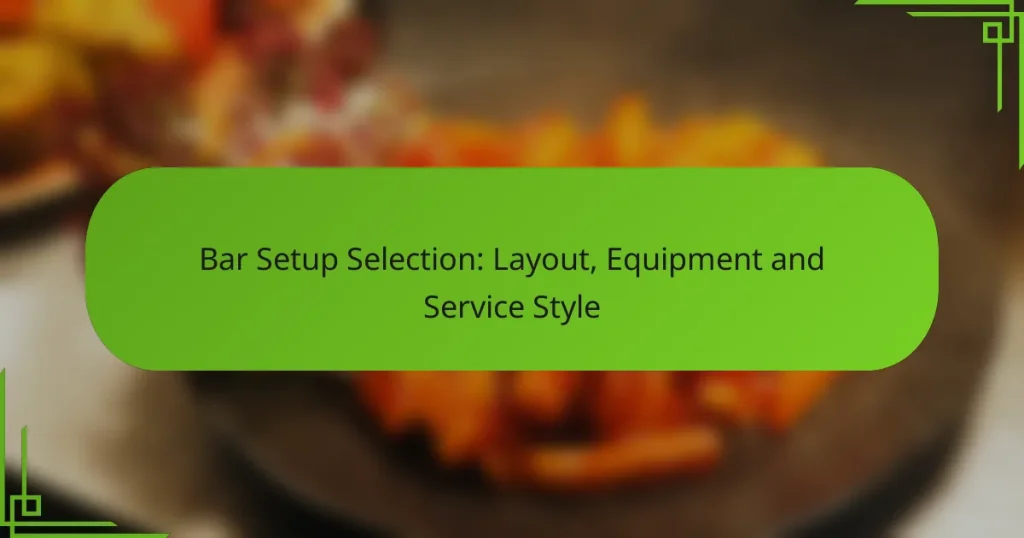When planning a bar setup for events, it’s essential to consider the layout, equipment, and service style to create an inviting and efficient environment. The layout should be tailored to the venue size and guest count, while the right equipment ensures a smooth operation. Additionally, selecting a service style that aligns with the atmosphere and clientele can enhance the overall experience for guests.

What are the best bar layouts for events in Los Angeles?
The best bar layouts for events in Los Angeles depend on the venue size, guest count, and service style. Popular layouts include linear, U-shaped, island, multi-level, and outdoor configurations, each offering unique advantages for different types of gatherings.
Linear bar layout
A linear bar layout features a straight bar counter, allowing for efficient service and easy access for guests. This setup is ideal for smaller venues or events with a limited number of attendees, as it maximizes space and minimizes congestion.
When implementing a linear layout, consider placing the bar against a wall or in a corner to optimize flow. Ensure that bartenders have enough room to work efficiently and that guests can easily approach the bar without blocking pathways.
U-shaped bar layout
The U-shaped bar layout creates an inviting atmosphere, encouraging social interaction among guests. This design allows for service on three sides, making it suitable for larger events where multiple bartenders can work simultaneously.
To enhance the U-shaped layout, incorporate seating around the bar for guests to relax. Ensure that the layout allows for clear movement and access to drinks, minimizing wait times during peak hours.
Island bar layout
An island bar layout is a freestanding bar that can be accessed from all sides, promoting a lively and engaging environment. This setup works well for outdoor events or large indoor spaces, as it encourages mingling and interaction.
When using an island layout, consider the placement of the bar in relation to other event features, such as seating and entertainment. This layout can be particularly effective when combined with high-top tables to create a dynamic social space.
Multi-level bar layout
A multi-level bar layout features varying heights, which can create visual interest and enhance the guest experience. This design is particularly effective for themed events or venues with a unique architectural style.
When designing a multi-level bar, ensure that the height differences are accessible and safe for all guests. Incorporating steps or ramps can help facilitate movement, while decorative elements can enhance the overall aesthetic.
Outdoor bar layout
Outdoor bar layouts are perfect for events in Los Angeles, where the climate often allows for open-air gatherings. These setups can range from simple portable bars to elaborate structures with seating and shade options.
For outdoor bars, consider factors such as weather protection, accessibility, and proximity to other event features. Providing adequate lighting and heating can enhance the experience, especially during evening events.

How to choose bar equipment for a successful setup?
Choosing the right bar equipment is crucial for creating an efficient and appealing setup. Consider factors such as the type of beverages you will serve, the space available, and the service style to ensure a successful bar operation.
Essential bar tools
Essential bar tools include items like shakers, strainers, jiggers, and muddlers. These tools help bartenders mix and serve drinks effectively. Investing in high-quality tools can enhance the speed and quality of service.
When selecting tools, consider ergonomics and durability. Stainless steel options are often preferred for their longevity and ease of cleaning. Make sure to have a complete set that covers all drink types you plan to offer.
Recommended glassware types
Choosing the right glassware is vital for both presentation and functionality. Common types include highball glasses, cocktail glasses, and wine glasses, each suited for specific beverages. Ensure you have a variety to accommodate your drink menu.
Consider the material as well; tempered glass is more durable and less likely to break. Additionally, having a consistent style can enhance the overall aesthetic of your bar, making it more inviting to customers.
Popular beverage dispensers
Beverage dispensers are essential for serving drinks efficiently, especially in high-volume settings. Options include tap systems for draft beer, cocktail dispensers, and juice dispensers. Choose dispensers that match your beverage offerings and service style.
When selecting dispensers, consider the ease of use and maintenance. For example, a well-designed tap system can reduce wait times and improve customer satisfaction. Look for dispensers that are easy to clean and refill to streamline operations.
Ice storage solutions
Effective ice storage is crucial for maintaining drink quality and service speed. Options include ice bins, ice makers, and ice chests. Choose a solution that fits your bar’s volume needs and available space.
Ensure that your ice storage complies with health regulations, which often require proper insulation and drainage. Regular maintenance is key to preventing contamination and ensuring a steady supply of ice during peak hours.

What service styles work best for bars in San Francisco?
In San Francisco, the best service styles for bars often depend on the venue’s size, clientele, and overall atmosphere. Full-service bars, self-service options, and mobile bar services each offer unique advantages that cater to different customer experiences.
Full-service bar
A full-service bar provides a comprehensive drinking experience where trained bartenders serve patrons directly. This style is ideal for establishments aiming to create a social atmosphere, as it allows for personalized service and interaction.
Considerations for a full-service bar include staffing levels, drink menu variety, and space for patrons to comfortably engage with bartenders. This setup typically requires a larger investment in equipment and staff training.
Self-service bar
A self-service bar allows customers to pour their own drinks, which can enhance the experience of socializing and exploring different beverages. This style is often seen in casual settings or events where guests prefer a more relaxed atmosphere.
When implementing a self-service bar, ensure that there are clear guidelines for usage and that the setup includes necessary equipment like taps or dispensers. This approach can reduce labor costs but may require careful management to prevent overconsumption.
Mobile bar service
Mobile bar services bring the bar experience directly to events, offering flexibility and convenience. This option is popular for weddings, corporate events, and private parties in San Francisco, where space may be limited.
When considering a mobile bar, evaluate the range of services offered, such as cocktail mixing or themed setups. Ensure that the service complies with local regulations regarding alcohol service at events.
Cash bar vs. open bar
A cash bar requires patrons to pay for their drinks, while an open bar allows guests to enjoy drinks at no cost, typically funded by the host. Each option has its benefits and drawbacks depending on the event type and budget.
Cash bars can help manage costs and reduce waste, but may deter some guests. Open bars create a festive atmosphere but can lead to higher expenses. Consider your audience and event goals when choosing between these styles.

What factors influence bar setup selection?
Bar setup selection is influenced by several key factors, including the size and type of the event, the layout and accessibility of the venue, and the preferences of the target audience. Understanding these elements helps ensure an efficient and enjoyable bar experience for guests.
Event size and type
The size and type of an event significantly dictate the bar setup. For smaller, intimate gatherings, a simple bar cart may suffice, while larger events often require multiple stations to accommodate high guest volumes. Consider the nature of the event—formal events may benefit from a more sophisticated setup, while casual gatherings can embrace a relaxed bar style.
When planning, estimate the number of guests and the duration of the event. A good rule of thumb is to have one bartender for every 50-75 guests for efficient service. This helps prevent long wait times and enhances the overall experience.
Venue layout and accessibility
The layout and accessibility of the venue play crucial roles in bar setup selection. A well-designed space allows for smooth guest flow and easy access to the bar. Ensure the bar is positioned in a location that is visible and convenient, avoiding areas that may cause congestion or obstruct pathways.
Consider the physical dimensions of the bar setup. For instance, a long bar may be ideal for large crowds, while a circular setup can facilitate interaction in smaller spaces. Always check for any venue regulations regarding setup and service areas to ensure compliance.
Target audience preferences
Understanding the preferences of the target audience is vital for effective bar setup. Different demographics may have varying tastes in beverages, service styles, and overall ambiance. For example, a younger crowd may prefer trendy cocktails, while an older audience might favor classic drinks.
Gather insights on your audience’s preferences through surveys or past event feedback. This information can guide decisions on drink selections, bar design, and even staff attire, ensuring that the bar resonates with the guests and enhances their experience.

How does bar setup affect customer experience?
The setup of a bar significantly influences customer experience by shaping service efficiency, social dynamics, and overall satisfaction. A well-planned layout and appropriate equipment can enhance interactions and streamline service, while a poor setup may lead to frustration and delays.
Impact on service speed
Service speed is crucial in a bar environment, as customers often expect quick access to drinks and food. An efficient bar layout, with strategically placed equipment like ice bins, mixers, and glassware, can reduce the time bartenders spend moving around. For instance, a U-shaped bar allows multiple bartenders to serve customers simultaneously, improving overall speed.
Consider the flow of customer traffic when designing the bar. Ensure that there is enough space for patrons to order without blocking others. A good rule of thumb is to allow at least 60-90 cm of space per customer at the bar to facilitate smooth movement and quick service.
Influence on social interactions
The bar setup plays a vital role in fostering social interactions among customers. A layout that encourages mingling, such as high-top tables or communal seating, can enhance the social atmosphere. In contrast, a cramped or isolated setup may discourage conversation and limit engagement.
Additionally, the positioning of the bar itself can affect how patrons interact. Bars that are open and inviting, with a clear view of the surrounding area, tend to create a more vibrant social environment. Consider incorporating elements like bar stools that face each other or group seating to promote interaction among guests.


